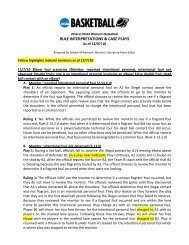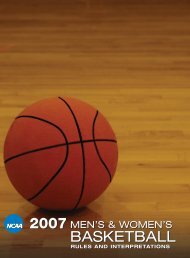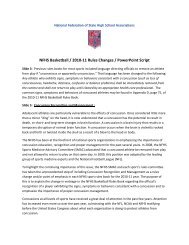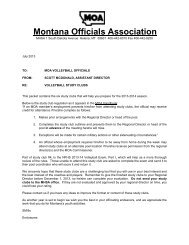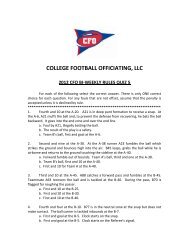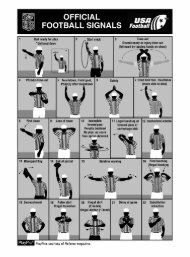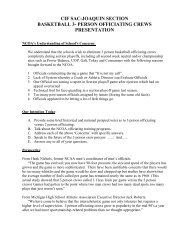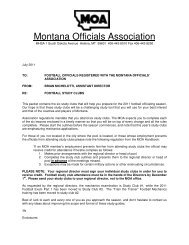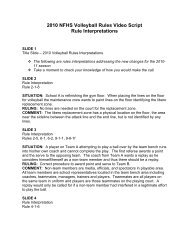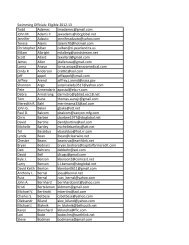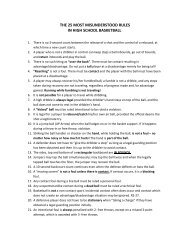2011-12 AND 2012-13 MEN'S AND WOMEN'S RULES - NAIA
2011-12 AND 2012-13 MEN'S AND WOMEN'S RULES - NAIA
2011-12 AND 2012-13 MEN'S AND WOMEN'S RULES - NAIA
Create successful ePaper yourself
Turn your PDF publications into a flip-book with our unique Google optimized e-Paper software.
RULE 4 / DEFINITIONS47<br />
line extended from the free-throw lane line nearest the bench area meeting an<br />
imaginary line extended from the coaching-box line.<br />
Section 8. Bench Personnel<br />
Art. 1. Bench personnel includes anyone in the team bench area and any team<br />
member before the start of the game, during the game and after the signal to end<br />
any period.<br />
Section 9. Blocking<br />
Art. 1. Blocking is illegal personal contact that impedes the pro gress of an<br />
opponent.<br />
Section 10. Bonus Free Throws<br />
Art. 1. One type of bonus free throw is a second free throw that is awarded for<br />
each common foul (except a player-control or team-control foul) committed by a<br />
player of a team, beginning with the seventh team foul in a half, provided that the<br />
first free throw for the foul is successful.<br />
Art. 2. The other type of bonus free throw occurs starting with the offending<br />
team’s 10th team foul in a half. From this point, two free throws shall be awarded<br />
for each common foul (except a player-control or team-control foul).<br />
Art. 3. The team-foul total shall consist of a combination of the following fouls:<br />
a. (Men) Personal fouls (includes player-control fouls) and CLASS A<br />
technical fouls.<br />
b. (Women) Personal fouls (includes player-control fouls) and player/<br />
substitute and bench technical fouls.<br />
Section 11. Boundary Lines<br />
Boundary lines of the playing court shall consist of end lines and sidelines. The<br />
inside edges of these lines define the inbounds and out-of-bounds areas.<br />
Section <strong>12</strong>. Charging<br />
Art. 1. Charging is illegal personal contact by pushing or moving into an<br />
opponent’s torso.<br />
Section <strong>13</strong>. Closely Guarded<br />
Art. 1. (Men) A player in control of the ball in the front court only while holding<br />
or dribbling the ball is closely guarded when his opponent is in a guarding stance<br />
at a distance not exceeding 6 feet. This distance shall be measured from the<br />
forward foot or feet of the defender to the forward foot or feet of the opponent.<br />
Art. 2. (Women) A player in control of the ball anywhere on the playing court<br />
while holding (not dribbling) the ball is closely guarded when her opponent is<br />
in a guarding stance at a distance not exceeding 3 feet. This distance shall be<br />
measured from the forward foot or feet of the defender to the forward foot or feet<br />
of the opponent.<br />
Art. 3. After the start of a five-second closely guarded count, in order for a<br />
closely guarded violation to occur, there shall be continuous guarding by the<br />
same opponent.<br />
Art. 4. When a player is positioned between the player in control of the ball and<br />
his or her opponent, who is within 6 feet (men) or 3 feet (women), a closely<br />
guarded situation does not exist.




